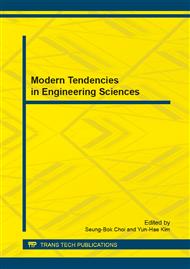p.207
p.211
p.214
p.218
p.226
p.230
p.237
p.242
p.247
Numerical Simulation of Radar Velocity Tomography Using SIRT and ART
Abstract:
Layer structure is an important reference basis for evaluating quality of land reclamation. Classical methods like digging profiles cost much time and energy. GPR (Ground Penetrating Radar) is a non-destructive and high-efficient technique. Aiming at the problem that insufficient reflected signal energy using traditional reflection method, tomography can be used in GPR detection for layer structure of mine reclamation soil. A model with four layers with different wave velocity is constructed and both ART and SIRT are employed to solve the inversion equations. The results show agreement with model data, and the difference between layers is clear. This verifies radar tomography technology is practical for detection layer structure of mine reclamation soil. The two algorithms give similar results and ART shows better accuracy while SIRT provides more stable results.
Info:
Periodical:
Pages:
226-229
Citation:
Online since:
February 2014
Authors:
Keywords:
Price:
Сopyright:
© 2014 Trans Tech Publications Ltd. All Rights Reserved
Share:
Citation:


